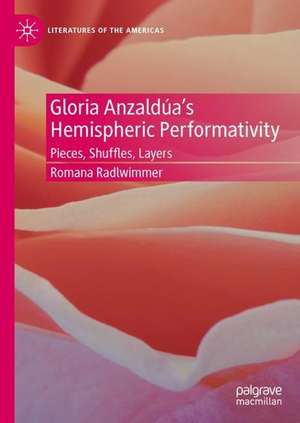Gloria Anzaldúa’s Hemispheric Performativity: Pieces, Shuffles, Layers: Literatures of the Americas
Autor Romana Radlwimmeren Limba Engleză Hardback – 6 apr 2023
Din seria Literatures of the Americas
- 20%
 Preț: 690.23 lei
Preț: 690.23 lei -
 Preț: 386.39 lei
Preț: 386.39 lei - 15%
 Preț: 693.25 lei
Preț: 693.25 lei -
 Preț: 388.72 lei
Preț: 388.72 lei -
 Preț: 451.48 lei
Preț: 451.48 lei -
 Preț: 388.72 lei
Preț: 388.72 lei - 15%
 Preț: 641.85 lei
Preț: 641.85 lei - 9%
 Preț: 627.85 lei
Preț: 627.85 lei -
 Preț: 387.75 lei
Preț: 387.75 lei - 15%
 Preț: 469.55 lei
Preț: 469.55 lei -
 Preț: 382.95 lei
Preț: 382.95 lei - 15%
 Preț: 637.10 lei
Preț: 637.10 lei - 15%
 Preț: 583.13 lei
Preț: 583.13 lei -
 Preț: 377.95 lei
Preț: 377.95 lei -
 Preț: 388.72 lei
Preț: 388.72 lei -
 Preț: 418.07 lei
Preț: 418.07 lei - 15%
 Preț: 640.37 lei
Preț: 640.37 lei -
 Preț: 381.00 lei
Preț: 381.00 lei -
 Preț: 388.13 lei
Preț: 388.13 lei - 15%
 Preț: 641.53 lei
Preț: 641.53 lei -
 Preț: 418.29 lei
Preț: 418.29 lei -
 Preț: 449.35 lei
Preț: 449.35 lei -
 Preț: 384.70 lei
Preț: 384.70 lei - 15%
 Preț: 465.98 lei
Preț: 465.98 lei -
 Preț: 422.90 lei
Preț: 422.90 lei -
 Preț: 384.48 lei
Preț: 384.48 lei - 15%
 Preț: 639.41 lei
Preț: 639.41 lei -
 Preț: 450.88 lei
Preț: 450.88 lei - 18%
 Preț: 726.06 lei
Preț: 726.06 lei - 15%
 Preț: 586.23 lei
Preț: 586.23 lei - 9%
 Preț: 758.26 lei
Preț: 758.26 lei - 15%
 Preț: 584.26 lei
Preț: 584.26 lei -
 Preț: 387.75 lei
Preț: 387.75 lei -
 Preț: 384.48 lei
Preț: 384.48 lei -
 Preț: 384.70 lei
Preț: 384.70 lei
Preț: 350.12 lei
Nou
Puncte Express: 525
Preț estimativ în valută:
66.99€ • 69.95$ • 55.32£
66.99€ • 69.95$ • 55.32£
Carte tipărită la comandă
Livrare economică 15-29 aprilie
Preluare comenzi: 021 569.72.76
Specificații
ISBN-13: 9783031218699
ISBN-10: 3031218698
Pagini: 117
Ilustrații: VII, 117 p. 5 illus.
Dimensiuni: 148 x 210 mm
Greutate: 0.3 kg
Ediția:1st ed. 2023
Editura: Springer International Publishing
Colecția Palgrave Macmillan
Seria Literatures of the Americas
Locul publicării:Cham, Switzerland
ISBN-10: 3031218698
Pagini: 117
Ilustrații: VII, 117 p. 5 illus.
Dimensiuni: 148 x 210 mm
Greutate: 0.3 kg
Ediția:1st ed. 2023
Editura: Springer International Publishing
Colecția Palgrave Macmillan
Seria Literatures of the Americas
Locul publicării:Cham, Switzerland
Cuprins
1. Performative Concepts of the Americas.- 2. Scissors and Glue: Material Writing Dynamics.- 3. Bones and Skin: Anzaldúa’s Bodymindsouls.- 4. Colors and Shapes: From Borderlands to Nepantla.- 5. Three Museums: “Border Arte’s” Multiplications.- 6. A Hemispheric Perspective on Anzaldúan Textualities.
Notă biografică
Romana Radlwimmer is Professor of Romance Literatures at the Goethe University of Frankfurt, Germany. Before, She has held teaching and research positions in literary and cultural studies at the Universities of Salamanca, Lisbon, Augsburg, and Tübingen, and was a Fulbright Visiting Scholar at the University of Missouri, US Kansas City. She is the author of Wissen in Bewegung: LatinaKulturtheorie / Literaturtheorie / Epistemologie (2015), and the editor of the volume Transborder Matters: Circulaciones literarias y transformaciones culturales chicanas y mexicanas (2020). She has published numerous peer-reviewed articles in her fields of research.
Textul de pe ultima copertă
This Palgrave Pivot offers new insights into leading Chicana writer Gloria Anzaldúa, investigating the dynamic composition of her texts, and situating her work in a larger hemispheric tendency of performativity emerging at the turn of the millennium. Presenting Anzaldúa as a quintessential figure of feminist and decolonial theory-making in the Americas, this book argues that the Chicana writer articulated her notions on fluctuations through “performative concepts” which did not respect the borders of single texts or editions, but organically grew through them. The offered close readings of Anzaldúa’s published works, drafts, and archive material demonstrate the constant changes and intertwined phases of her literary and conceptual production.
Romana Radlwimmer is Professor of Romance Literatures at the Goethe University of Frankfurt, Germany. She has held teaching and research positions in literary and cultural studies at the Universities of Salamanca, Lisbon, Augsburg, and Tübingen, and was a Fulbright Visiting Scholar at the University of Missouri, US. She is the author of Wissen in Bewegung: LatinaKulturtheorie / Literaturtheorie / Epistemologie (2015), and the editor of the volume Transborder Matters: Circulaciones literarias y transformaciones culturales chicanas y mexicanas (2020). She has published numerous peer-reviewed articles in her fields of research.
Caracteristici
Explores Anzaldúa’s contribution to the wave of feminist performativity in the Americas at the turn of the millennium Builds on performance studies, as well as feminist and decolonial theory Sheds new light on the materiality and intertextuality of Anzaldúa’s texts
